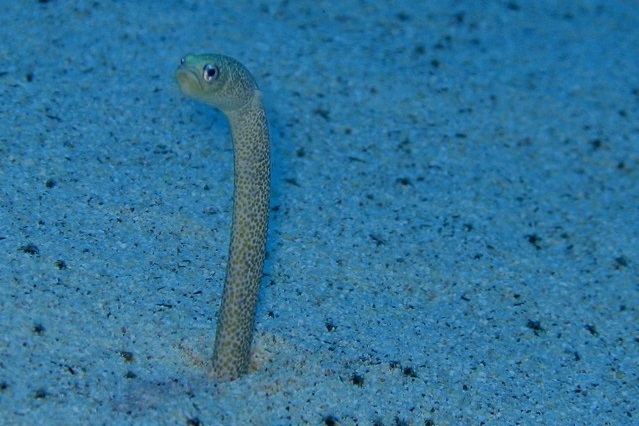Gorgasia sillneri
| Latin name | Gorgasia sillneri - Klausewitz, 1962 |
|---|---|
| Family | Congridae - Gorgasia |
| Origin | The Red Sea |
| Max length | 84 cm (33.1") |
| Minimum volume |
400 l (106 gal) |
|---|---|
| Hardiness |
Average |
| Suitable for aquarium |
Suitable for special aquariums |
| Reef safe |
Always reef safe |
| Aggressiveness | Peaceful |
| Recommended |
Small crustaceans (Krill, mysis, artemia...) Zooplankton (Cyclops, pods...) |
|---|
This species is known to jump out of open aquaria.
Since these fish are very shy, there are difficulties feeding them at first as they are reluctant to come out of their holes.
Most aquarists report however, that once they appear, they eat well.
One must make certain that there are no aggressive fish in the aquarium and they should not be kept with creatures which dig into the sandy bottom.
It is obvious that these fish must have as short a journey to their final aquarium as possible, as they do not normally have the optimum conditions in the petshop.
This species ought to be kept in a group of at least three.
There is a greater chance of success with this species if one can supply a living feed to allow it to adapt to the tank.
This fish requires feeding several times a day, especially when newly added.
When the fish can find its natural food in the aquarium it requires less frequent feeding.
This species must be kept in an aquarium with at least a 20 cm layer of fine sand.
The layer should resemble the length of the fish.
If necessary topped with another layer if the sand swirls round too much.
Eels are a large family, but mainly the subfamily, Garden eel (Heterocongrinae) are relevant in relation to aquaria.
Garden eels live together in groups. They require enough sand in the aquarium substrate to make their small but deep holes, also the more one wishes to keep the larger the sand surface needs to be.
The minimum number kept, should be 3, the optimum is between 6 and 10. Each eel however, needs at least an area of 12 by 12 inch (30 by 30 cm).
They eat zooplankton from the water column, which is difficult to maintain in an aquarium. At first one needs to have live Artemia and preferably a healthy population of zooplankton. Later on they can be fed with frozen foods, provided this can be fed in such a manner that it floats gently past the eels so it can be caught.
| Aquarium trade | No |
|---|---|
| Distribution | Western Indian Ocean: Gulf of Aqaba, Red Sea. |
Scott W. Michael. 2001. Reef Fishes volume 1 - TFH Publications / Microcosm Ltd. - (English)
Raul Roman. 2011. Aquarium Fish: A Detailed look at the Home Aquarium Husbandry of the Spotted Garden Eel - Advanced Aquarist - (English)
Bob Fenner. The Conger & Garden Eels, Family Congridae - Wet Web Media - (English)


